Slow Fibres
Fibershed is building regenerative textile practices from Northern California to Sri Lanka. What are the obstacles to taking a local system global?

‘This is a slow movement, please allow a few days for a response’ read most of the auto-replies I received from Fibershed affiliates when researching this article. The turn to slowness in the face of the urgency of the climate crisis is one of the many contradictions that bioregionalism requires us to confront. Another is jumps in scale: can networks of locally rooted organisations like Fibershed, an organisation developing regional fibre systems, really help us tackle this global crisis?
Fibershed began its operations in Northern California in 2011 with a quest to understand what it would take for a person to have all the clothing they needed for a year sourced, processed and produced from within a 200-mile radius of where they lived. I asked Heather Podoll, the Partnership and Advocacy Coordinator at Fibershed, how she would describe it – was it a network? A brand? An institution?
‘Fibershed is a word that our founder invented, in the spirit of a watershed, or a term a lot of people use now: foodshed,’ she says. ‘We sometimes have to explain that Fibershed is the name of our organisation but we use it with a lower-case “f” too, as a concept through which we can think about fibre strategies with the lens of the bioregion where we live.’
Understanding the California ‘fibreshed’ also meant understanding the community in the region and its gaps and potentials; its ecosystem of fields, fibre-producers, processors, artisans, manufacturers, retailers, livestock, sheep-shearers and mills. Questions such as ‘how much wool is produced in California?’, ‘how much of that can be worn next to skin?’ and ‘where does California’s wool go?’, helped founder Rebecca Burgess and her team to understand how the project might unfold. The organisation developed its activities under three core pillars of focus: climate-benefiting agriculture (working with farmers to provide grants and share information on producing high-quality natural fibres like cotton, linen and wool in ways that sequester carbon and restore ecosystem health through practices like crop rotations), regional textile economies (finanacial and technical assistance for decentralising textile production), and outreach and advocacy.
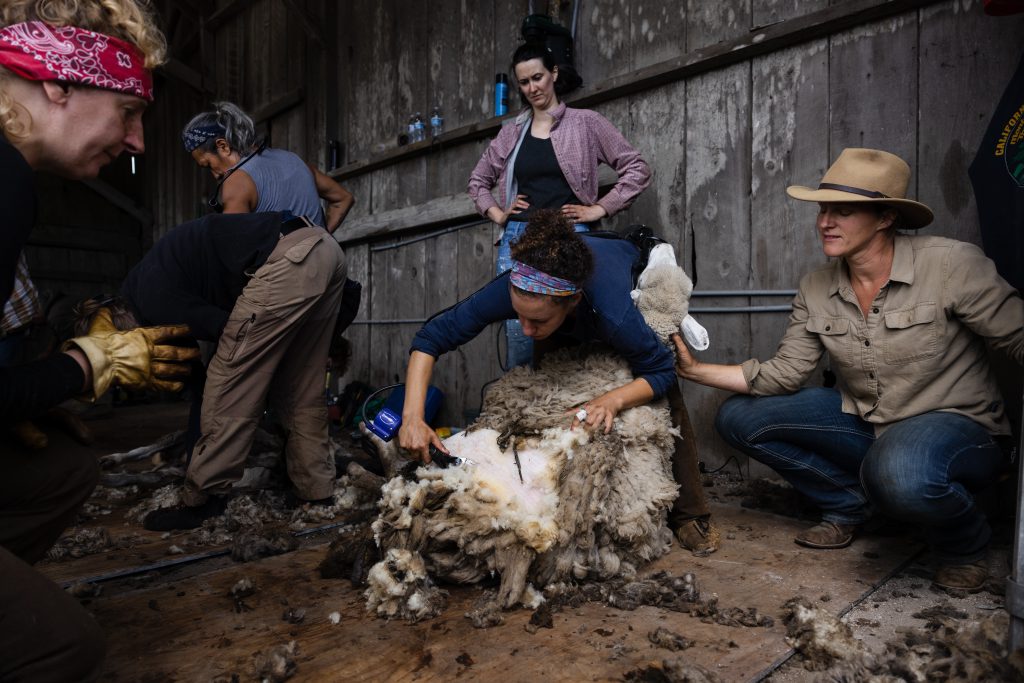
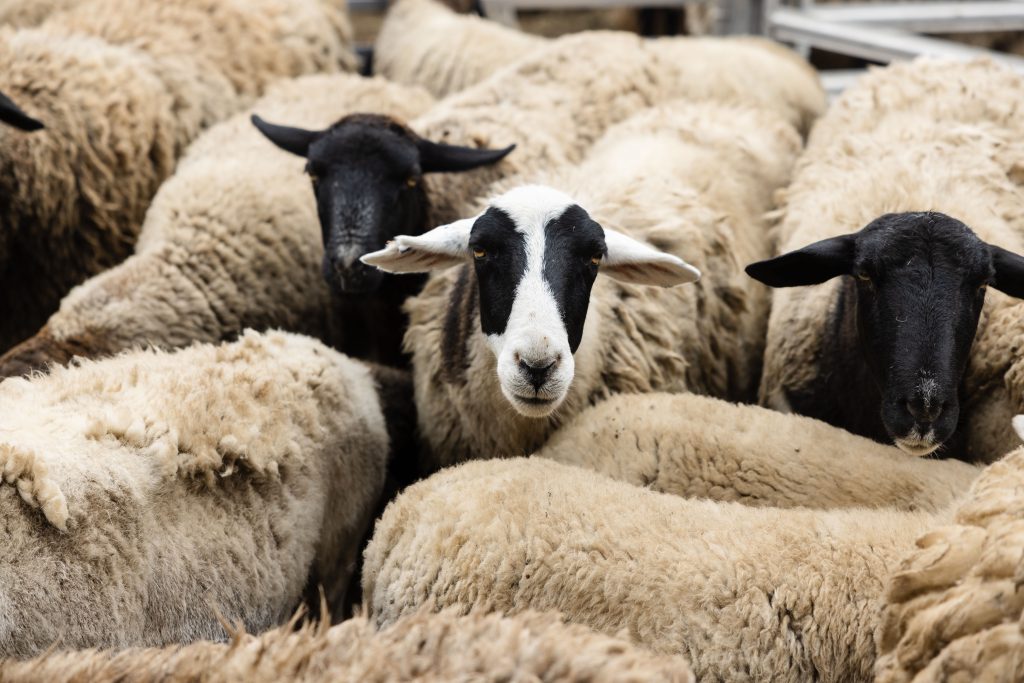
‘Fibershed is the name of our organisation but we use it with a lower-case “f” too, as a concept through which we can think about fibre strategies with the lens of the bioregion where we live.’
Heather Podoll
Ten years later, Fibershed has become a worldwide network of more than 70 affiliates, each aiming to establish regenerative textile systems which echo, but don’t simply replicate, Burgess’ experiments in California. The affiliates span from southern California to Spain to Sri Lanka and work across a wide range of projects. Crucially, the individual focus of the affiliate is shaped by their distinct bioregion and its textile and fibre producing potentials.
One early affiliate was Chico Flax, a flax farm also in Northern California set up by Sandy Fisher and Durl Van Alstyne in 2012. At this time Burgess was in dialogue with local producers like Chico Flax to explore ways in which pooling resources would allow for them to work as a cluster of small fibre producers that collectively contributed to the production of locally grown, processed and produced textiles. Sandy reflects, ‘My first vision of this was I thought I’d have a big factory, but now I’m realizing that because of the localisation, why not have small farms, small-scale processing equipment working together – I can see a goal that can be reached.’
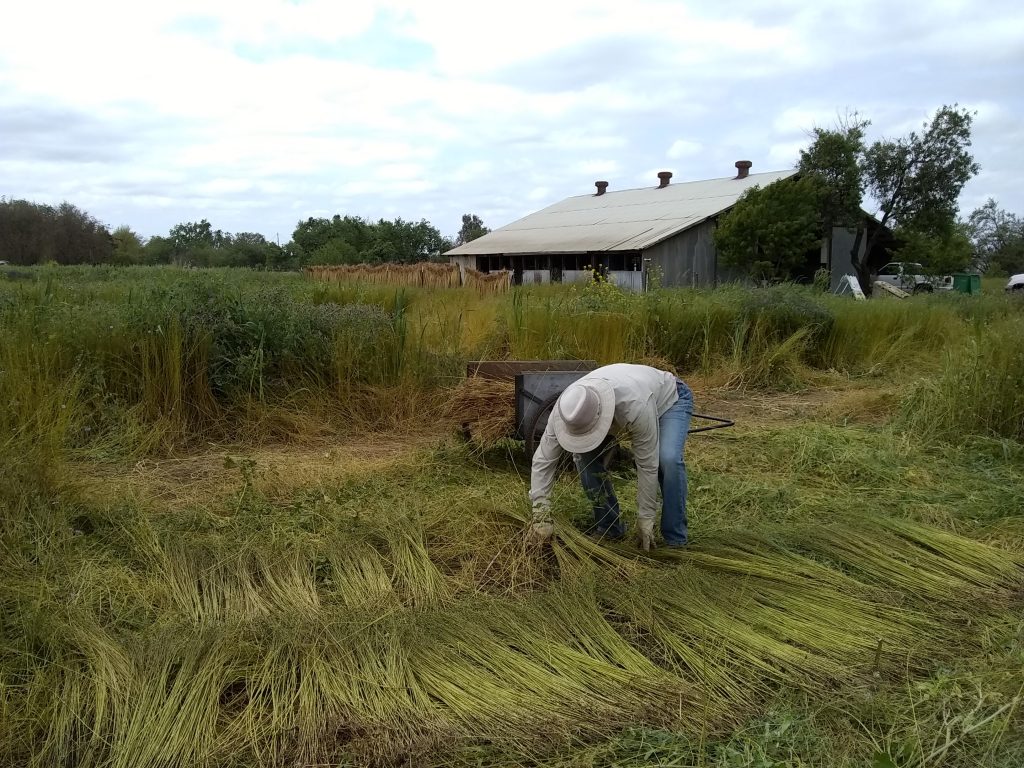
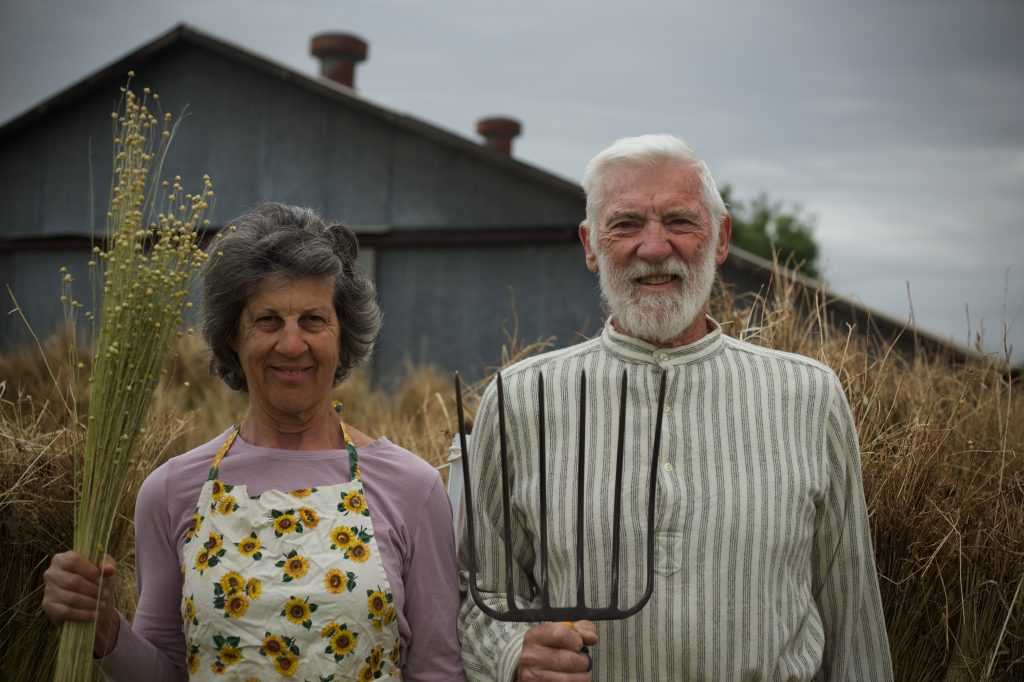
Chico Flax has not only established regenerative agriculture practices but a range of activities to support and propel these processes. Sandy and Durl describe the typical fifteen-year wait to see results with regenerative agriculture, but how last year, after twelve years, they were able to produce 1000 lbs (450 kg) of straw and this year they expect 10,000 lbs. ‘We are starting now to get some valuable data that is reliable,’ says Durl. They go on to explain how they’ve been able to produce five-foot flax fibres through the care of their practice – where typically fibres might only be three feet – and that overall, they are seeing leaps in quality and price for this produce. Key to the success of Chico Flax has been research collaboration with local universities and broader government funding for regenerative agriculture and soil-to-soil textile industries. Durl explains to me that they’ve been trying to get federal government funding to research the species of fibre flax that are best suited for the five distinct agriculturally suited climate zones found in Northern California.
Will the governments of the global south, where Fibershed affiliates are also located, be able to push these same practices forward at the same pace? Ideally, the knowledge-sharing, community-oriented approach of practices like Fibershed should assist in equating bioregions across political and economic borders, but inequalities tend to stack up unequally through the processes of globalisation.
In January 2024 I met with Thilina Premjayanth, Country Lead and Founder of Fibershed Sri Lanka, where I am also based. Thilina’s story is remarkable, having steered a career from eight years with the national airline to switching tracks and becoming a circular economy business developer in a quest to effect change. Thilina was introduced to Fibershed in 2021 and he began working with female artisans spread across towns like Tissamaharama, Monaragala and Ampara in the North West province of the island. At that time, the artisans were using rush and reed fibres to weave small objects like baskets and boxes; low cost items primarily aimed at tourists.
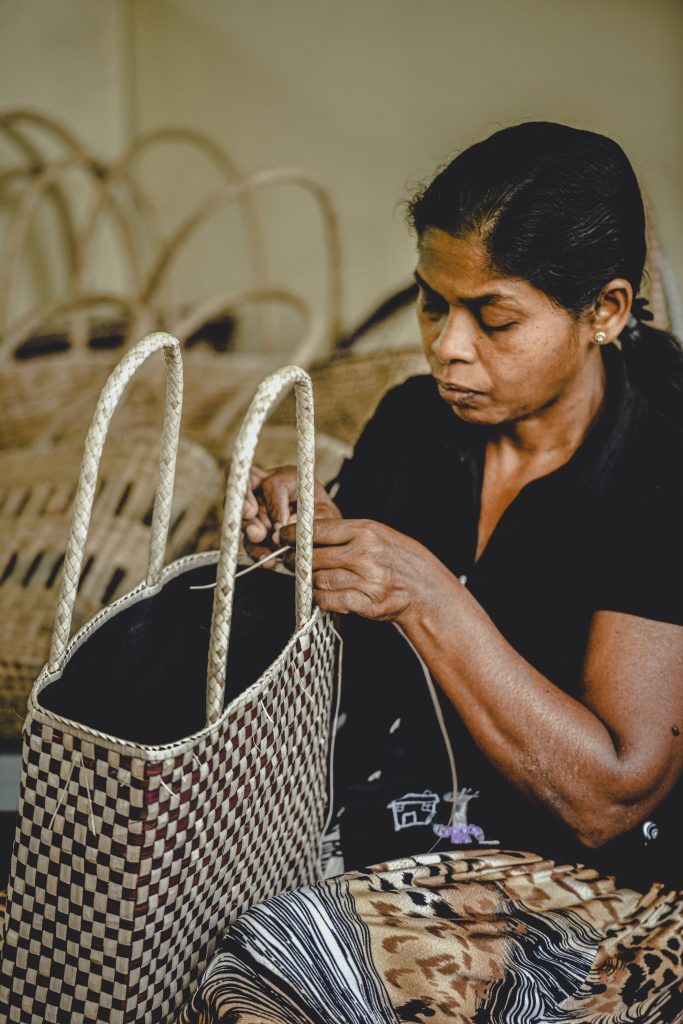
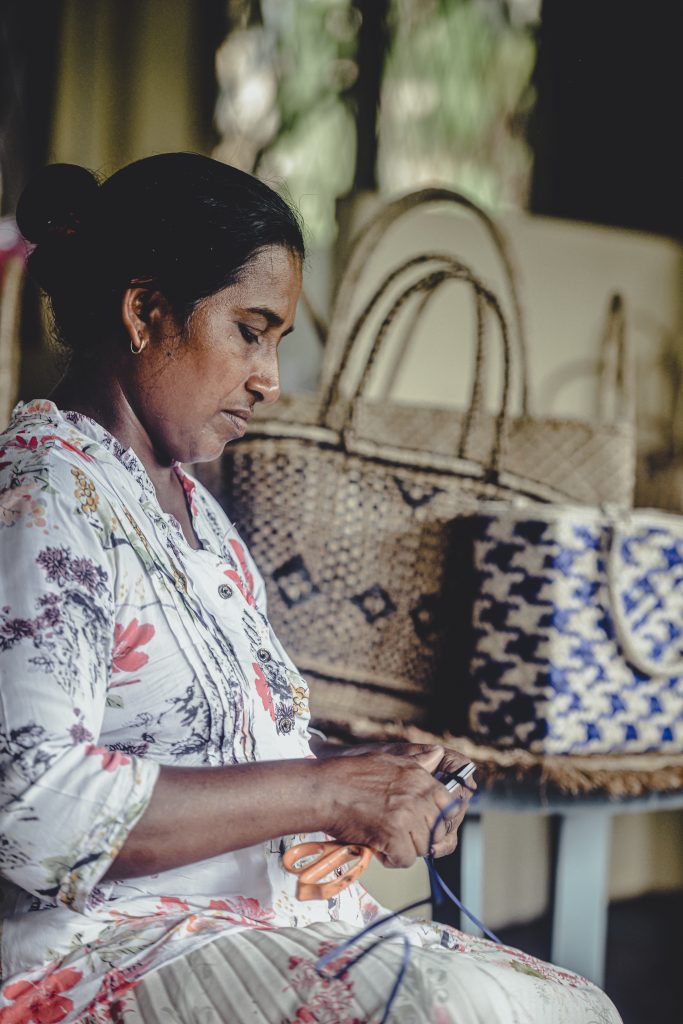
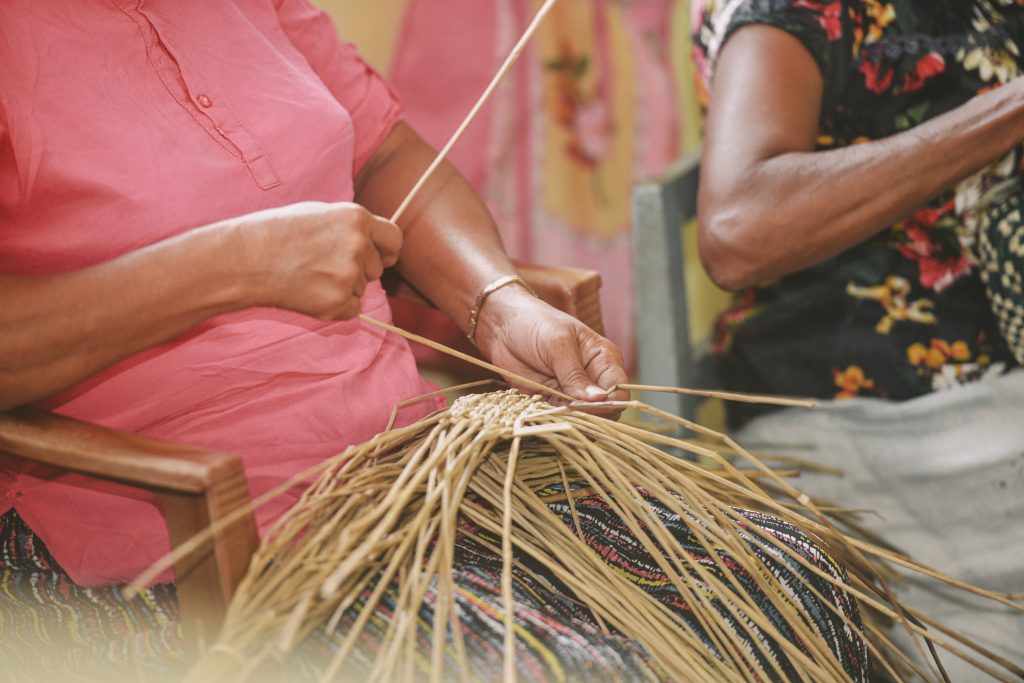
Premjayanth has large ambitions for Fibershed Sri Lanka, aiming, in time, to revive the country’s cotton industry which, in the 1960s and ’70s, comprised over 60,000 acres of cotton production (through centralised government channels) and is now completely defunct. For now though, he’s focusing on bridging the gap between Sri Lankan producers and international consumers, selling directly to the USA so that the revenue generated is sufficient to uplift the artisans’ incredibly harsh economic conditions. The women still produce objects like bags, baskets and boxes, but the designs are updated to suit foreign markets. For an artisan usually earning minimal daily or even only seasonal wages, the type of financial safety net offered by Fibershed Sri Lanka through higher selling prices and year-round demand can be invaluable.
‘What’s the point in selling just two bags a month?’
Thilina Premjayanth
When I asked Thilina about selling to the local market, he said he would not consider it: ‘What’s the point in selling just two bags a month?’ He explains that he had to convince the Fibershed ‘mothership’ in Northern California that, in a place like Sri Lanka, the majority of local consumers would not have the appetite or perhaps even the ability to buy the products at what would be considered a fair price in the West. In the USA, it may be conceivable that textile products could be locally sourced, fabricated, distributed and consumed, but in a place like Sri Lanka, where 80 per cent of the population is rural, extensive changes across government funding, disposable income and consumer culture are needed to even consider this kind of self-sustenance.
What’s more, 52 per cent of the country’s export income comes from the garment industry producing clothes for companies like Nike, GAP and Lululemon. In the event that bioregional, self-sufficient production becomes widespread in the US, there would be significant, if not catastrophic, ripple effects across the planetary supply chains currently in place. As Heather Podoll points out, Fibershed ‘doesn’t have an aspiration to be a single global organization’. Yet it cannot help but be entangled in the problems caused by globalisation.
Podoll goes on to point out that all regions in the world have traditional textile practices and acknowledges the impact of colonial practices on decimating these traditions in Sri Lanka and beyond. Is it really possible to conceive of a return to these traditional fibre practices or, as with the food industry, can the turning back of time only ever be partial? How would the drive towards self-sufficiency in the West, which seems even partially achievable, affect postcolonial economies like that of Sri Lanka, where there is such a keen reliance on export production for the Western Market? And yet, given the enormity of the impacts of the climate crisis and how they too would asymmetrically affect emerging economies, the importance of projects like Fibershed succeeding cannot be ignored; just one more contradiction to reconcile.